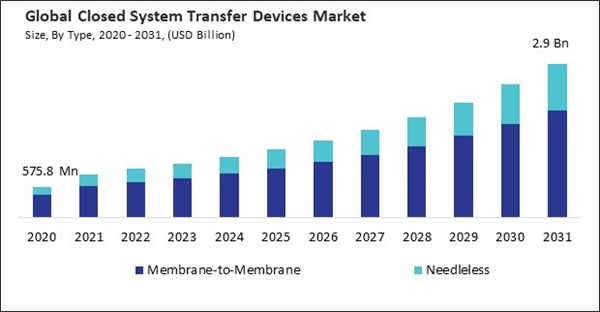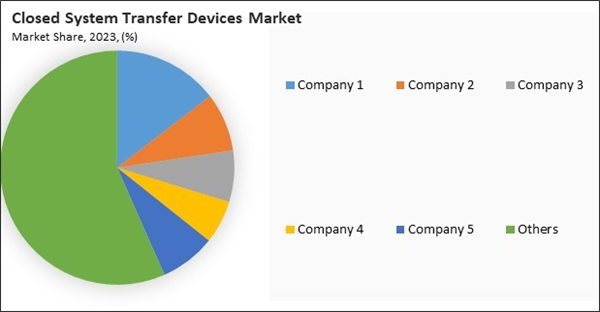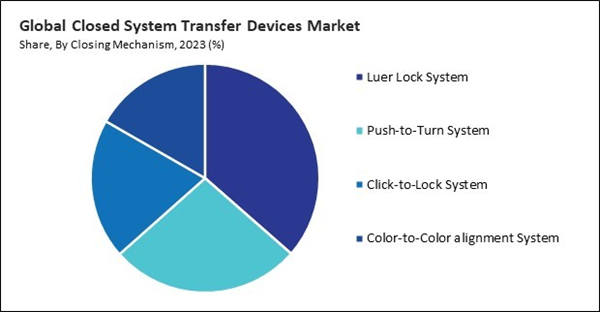The Global Closed System Transfer Devices Market size is expected to reach $2.9 billion by 2031, rising at a market growth of 14.2% CAGR during the forecast period.
Color-to-color alignment systems provide an additional layer of safety by ensuring proper connection and alignment between components of CSTDs. Therefore, the color-to-color alignment system segment captured approximately 1/4th share of the market in 2023. This feature helps minimize the risk of misconnections or improper assembly, leading to medication errors, drug spillage, or exposure to hazardous drugs.
With rising awareness about the potential health risks associated with exposure to hazardous drugs, there is a growing demand for safer handling practices among healthcare workers. CSTDs provide a closed system that minimizes the risk of exposure to harmful substances, thereby effectively addressing these safety concerns. Thus, the Increasing awareness of occupational hazards drives the market’s growth.
Additionally, as healthcare expenditures rise, providers allocate more resources to enhancing patient safety and minimizing risks associated with medical procedures. CSTDs offer a critical solution for reducing the risk of exposure to hazardous drugs among healthcare workers, aligning with the broader trend of prioritizing safety in healthcare settings. Therefore, the growing healthcare expenditure globally is promoting the market’s growth.
However, Implementing CSTDs requires a significant upfront investment for healthcare facilities. These costs include purchasing the devices themselves, as well as any required training for staff, infrastructure modifications, and ongoing maintenance expenses. In conclusion, the high initial costs of closed-system transfer devices hamper the market’s growth.
Global supply chains were disrupted by the COVID-19 pandemic, which impacted the manufacturing and distribution of medical equipment, particularly CSTDs. Manufacturers faced challenges such as raw material shortages, transportation delays, and workforce disruptions, leading to supply constraints and potential shortages in some regions. Thus, the COVID-19 pandemic moderately impacted the market.
The leading players in the market are competing with diverse innovative offerings to remain competitive in the market. The above illustration shows the percentage of revenue shared by some of the leading companies in the market. The leading players of the market are adopting various strategies in order to cater demand coming from the different industries. The key developmental strategies in the market are Acquisitions, and Partnerships & Collaborations.
Color-to-color alignment systems provide an additional layer of safety by ensuring proper connection and alignment between components of CSTDs. Therefore, the color-to-color alignment system segment captured approximately 1/4th share of the market in 2023. This feature helps minimize the risk of misconnections or improper assembly, leading to medication errors, drug spillage, or exposure to hazardous drugs.
With rising awareness about the potential health risks associated with exposure to hazardous drugs, there is a growing demand for safer handling practices among healthcare workers. CSTDs provide a closed system that minimizes the risk of exposure to harmful substances, thereby effectively addressing these safety concerns. Thus, the Increasing awareness of occupational hazards drives the market’s growth.
Additionally, as healthcare expenditures rise, providers allocate more resources to enhancing patient safety and minimizing risks associated with medical procedures. CSTDs offer a critical solution for reducing the risk of exposure to hazardous drugs among healthcare workers, aligning with the broader trend of prioritizing safety in healthcare settings. Therefore, the growing healthcare expenditure globally is promoting the market’s growth.
However, Implementing CSTDs requires a significant upfront investment for healthcare facilities. These costs include purchasing the devices themselves, as well as any required training for staff, infrastructure modifications, and ongoing maintenance expenses. In conclusion, the high initial costs of closed-system transfer devices hamper the market’s growth.
Global supply chains were disrupted by the COVID-19 pandemic, which impacted the manufacturing and distribution of medical equipment, particularly CSTDs. Manufacturers faced challenges such as raw material shortages, transportation delays, and workforce disruptions, leading to supply constraints and potential shortages in some regions. Thus, the COVID-19 pandemic moderately impacted the market.
The leading players in the market are competing with diverse innovative offerings to remain competitive in the market. The above illustration shows the percentage of revenue shared by some of the leading companies in the market. The leading players of the market are adopting various strategies in order to cater demand coming from the different industries. The key developmental strategies in the market are Acquisitions, and Partnerships & Collaborations.
By Component Analysis
Based on component, the market is categorized into vial access components, male luers, bag spikes, female components, and others. In 2023, the male luers segment witnessed 19.0% revenue share in the market. Male luers are designed to be compatible with a wide range of medical equipment, including syringes, IV tubing sets, and infusion pumps.By Technology Analysis
By technology, the market is divided into diaphragm-based devices, compartmentalized devices, and air cleaning/filtration devices. In 2023, the diaphragm-based devices segment registered 46.4% revenue share in the market. Diaphragm-based devices offer superior containment capabilities, ensuring the safe handling and transfer of hazardous drugs.By Closing Mechanism Analysis
Based on closing mechanism, the market is divided into luer lock system, push-to-turn system, click-to-lock system, and color-to-color alignment System. In 2023, the click-to-lock system segment attained 19.8% revenue share in the market. Click-to-lock systems are designed to be user-friendly and intuitive, allowing healthcare workers to assemble CSTD components quickly and efficiently.By End User Analysis
Based on end user, the market is divided into hospitals & clinics, oncology centers, and others. The hospitals & clinics segment attained 79.8% revenue share in the market in 2023. Hospitals and clinics handle many hazardous drugs daily, especially in oncology, pharmacy, and infusion therapy departments. These facilities administer chemotherapy, antibiotics, and other potent medications to patients, requiring strict adherence to safe drug-handling protocols.By Type Analysis
On the basis of type, the market is segmented into membrane-to-membrane and needleless. The membrane-to-membrane segment recorded 73.3% revenue share in the market in 2023. Membrane-to-membrane systems provide a high level of containment for hazardous drugs by creating a sealed barrier between the drug and the environment.By Regional Analysis
Region-wise, the market is analyzed across North America, Europe, Asia Pacific, and LAMEA. In 2023, the Asia Pacific region generated 25.5% revenue share in the market. The Asia Pacific region is experiencing a significant increase in the incidence of cancer, driven by factors such as aging populations, lifestyle changes, and environmental factors.List of Key Companies Profiled
- Becton, Dickinson and Company
- ICU Medical, Inc.
- B.Braun Melsungen AG
- Baxter International, Inc
- Terumo Corporation
- Equashield LLC
- Simplivia Healthcare Ltd.
- CODAN Medizinische Geräte GmbH
- Corning Incorporated
- Vygon SAS
Market Report Segmentation
By Type- Membrane-to-Membrane
- Needleless
- Vial access components
- Female Components
- Male Luers
- Bag Spikes
- Others
- Diaphragm-based devices
- Compartmentalized devices
- Air cleaning/filtration devices
- Luer Lock System
- Push-to-Turn System
- Click-to-Lock System
- Color-to-Color alignment System
- Hospitals & Clinics
- Oncology Centers
- Others
- North America
- US
- Canada
- Mexico
- Rest of North America
- Europe
- Germany
- UK
- France
- Russia
- Spain
- Italy
- Rest of Europe
- Asia Pacific
- China
- Japan
- India
- South Korea
- Singapore
- Malaysia
- Rest of Asia Pacific
- LAMEA
- Brazil
- Argentina
- UAE
- Saudi Arabia
- South Africa
- Nigeria
- Rest of LAMEA
Table of Contents
Chapter 1. Market Scope & Methodology
Chapter 2. Market at a Glance
Chapter 3. Market Overview
Chapter 4. Competition Analysis - Global
Chapter 5. Global Closed System Transfer Devices Market by Type
Chapter 6. Global Closed System Transfer Devices Market by Component
Chapter 7. Global Closed System Transfer Devices Market by Technology
Chapter 8. Global Closed System Transfer Devices Market by Closing Mechanism
Chapter 9. Global Closed System Transfer Devices Market by End User
Chapter 10. Global Closed System Transfer Devices Market by Region
Chapter 11. Company Profiles
Companies Mentioned
- Becton, Dickinson and Company
- ICU Medical, Inc.
- B. Braun Melsungen AG
- Baxter International, Inc
- Terumo Corporation
- Equashield LLC
- Simplivia Healthcare Ltd.
- CODAN Medizinische Geräte GmbH
- Corning Incorporated
- Vygon SAS
Methodology

LOADING...











